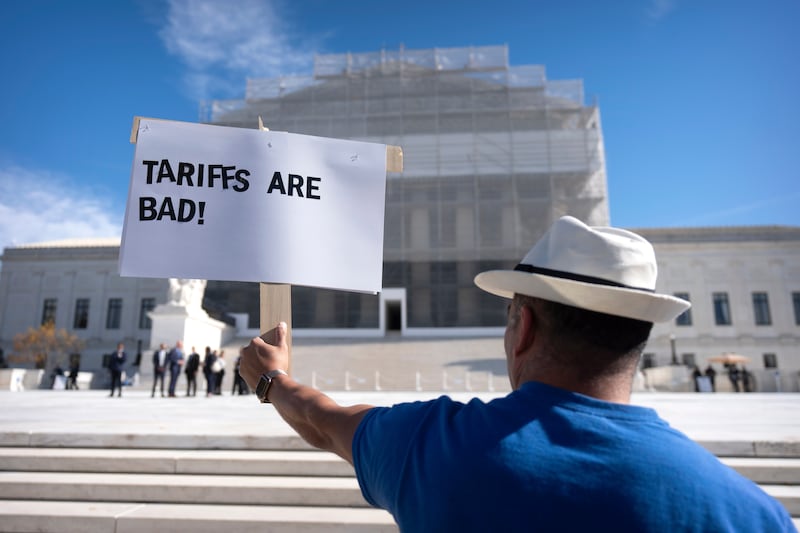The Supreme Court on Wednesday heard oral arguments on whether President Donald Trump had the power to enact his sweeping tariff agenda, with many of the justices expressing reservations about the president’s use of the economic tool during his second term.
The case centers on Trump’s “Liberation Day” tariffs announced in April and placed on virtually all of the United States’ trading partners, as well as earlier tariffs on imports from China, Mexico and Canada.
The president has defended his use of tariffs by declaring a national emergency under the International Emergency Economic Powers Act, or IEEPA. Trump argues that under IEEPA and the Constitution, he can impose tariffs to manage trade imbalances with other countries and curb the flow of fentanyl coming into the country, both things he contends are emergencies.
Lower courts found that the emergency law Trump invoked doesn’t give him unlimited power to enact tariffs since the Constitution says that power lies with Congress.
The justices on Wednesday appeared skeptical that the president was within his authority to impose the tariffs under the emergency act. All nine justices lobbed tough questions at the lawyers arguing the case.
Trump has been vocal about the case ahead of Wednesday’s hearing, and had suggested he may attend oral arguments in person. Instead he delivered remarks at the American Business Forum in Miami.
Treasury Secretary Scott Bessent was in attendance at the Supreme Court, along with Commerce Secretary Howard Lutnick.
The outcome of the case could come in just a few weeks or months, quicker than most decisions, and would have major implications for U.S. businesses and Trump’s trade agenda going forward.
Justices pressed administration for answers
During oral arguments, the justices pressed Solicitor General D. John Sauer, who represented the Trump administration, as well as attorneys representing the small businesses and various states that have challenged Trump’s actions.
Sauer faced more than an hour of questioning from the justices, with many pointed questions about the meaning of the tariffs. Sauer argued that the president put in regulatory tariffs, “not revenue-raising tariffs.” IEEPA contains the word “regulate” but not “tax” or “tariff.”
While Trump has repeatedly touted the amount of revenue his tariffs have generated for the government since they were enacted, Sauer stated that the fact the tariffs raise revenue was “only incidental.”
Sauer faced some of his toughest questioning from Justice Neil Gorsuch, who at one point noted that he was “struggling” to understand some of the administration’s argument and got Sauer to say that the president does not have authority over tariffs during peacetime or a time that is not a declared an emergency.
Gorsuch expressed skepticism of the administration’s argument bypassing the major questions doctrine, which means if Congress wanted to give the president economic power, it would have said so plainly.
Sauer also faced questions about former President Richard Nixon’s use of executive authority, including imposing a 10% tariff on imports to the U.S.
Nixon did not invoke IEEPA, but used the statute’s precursor, the Trading with the Enemy Act of 1917, or TWEA. Sauer argued IEEPA later incorporated TWEA, which prompted liberal Justice Elena Kagan to drill in on the differing language of the statutes.
Small businesses and states argue their side
Neal Katyal, an experienced attorney arguing before the Supreme Court and the former solicitor general for the Obama administration, represented the small businesses who challenged the administration’s tariffs.
He spoke about the precedent the justices would be setting in a case like this, including what future presidents would do. Katyal questioned the court about where they should draw the line between regulating and regulations. For example, the president can request the tariff power from Congress, but if the court rules in favor of the administration, Congress can’t have that power back, he said.
Katyal also spoke about the separation of powers and Congress’ “power of the purse” in economic and financial matters, likely in an appeal to three conservative justices, Samuel Alito, Clarence Thomas and Brett Kavanaugh.
Katyal highlighted the administration’s expression of how beneficial the tariffs have been economically for the country, including Sauer’s argument that it was merely “incidental.”
He faced almost an hour of questioning, with some similarly tough questions from Gorsuch, but the justices’ questions appeared to be less critical than the questions for Sauer.
Benjamin Gutman, the solicitor general of Oregon, argued on behalf of the 12 mostly Democratic states that sued over Trump’s tariffs.
His line of questioning from the justices was considerably shorter than Sauer or Katyal.
Where things stand now
It’s still not known how the justices will decide in this case, but Gorsuch, Justice Amy Coney Barrett and Chief Justice John Roberts appeared to be undecided in the case.
Gorsuch pressed Sauer and the administration hard during questioning. Barrett was difficult to read about where she stood on the case, as she asked sharp questions of each side.
Roberts, a key justice to watch in the case, often plays his cards close to his chest and was fairly quiet during arguments.
A decision in the case is expected to be issued sooner than is typical. Bessent said Tuesday on CNBC he believes the administration has other options to support tariffs if the Supreme Court decision doesn’t go the administration’s way.


